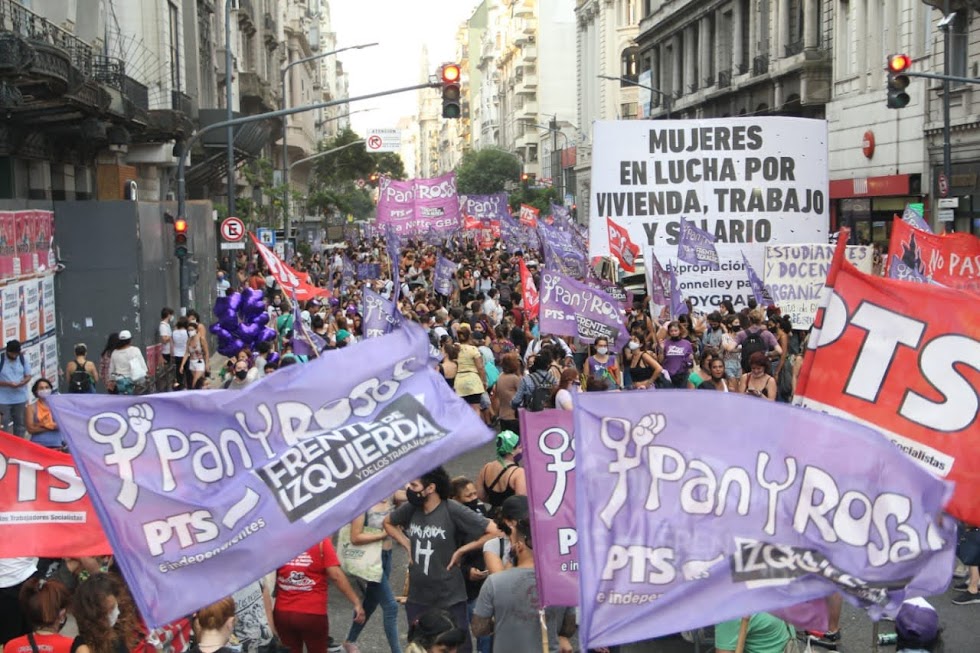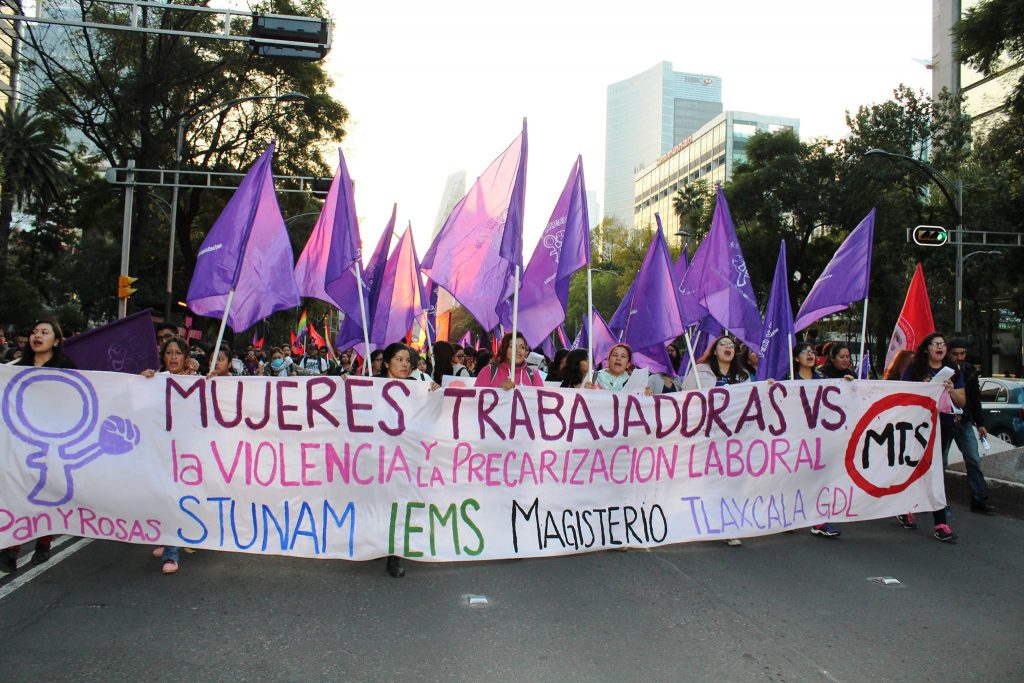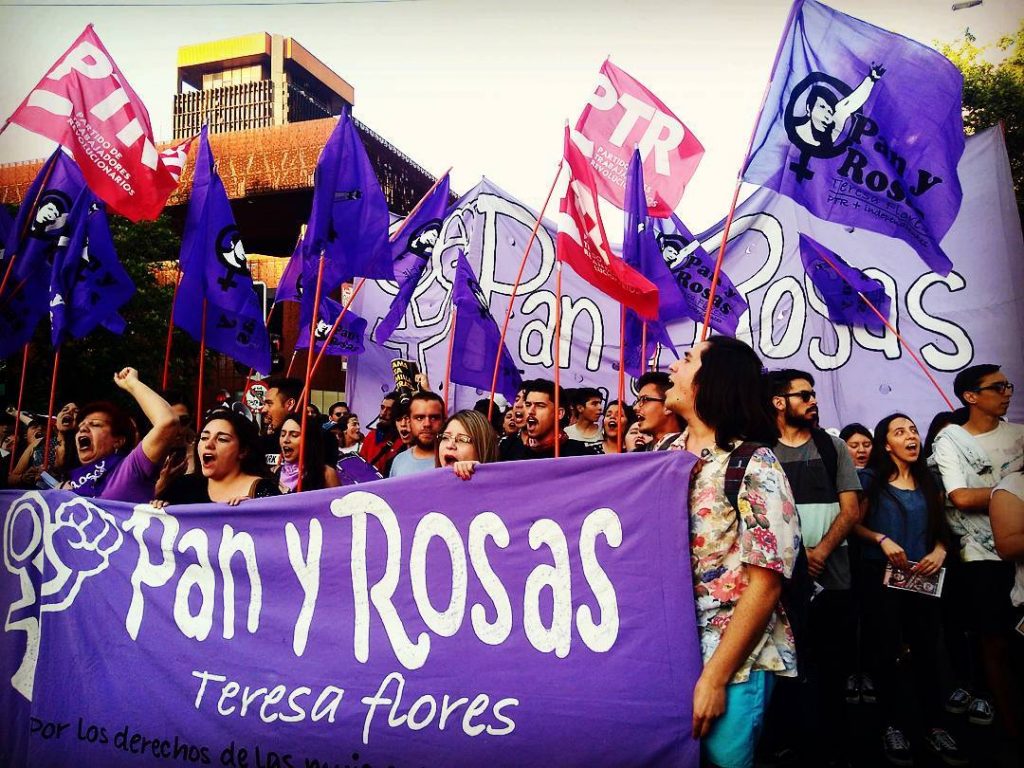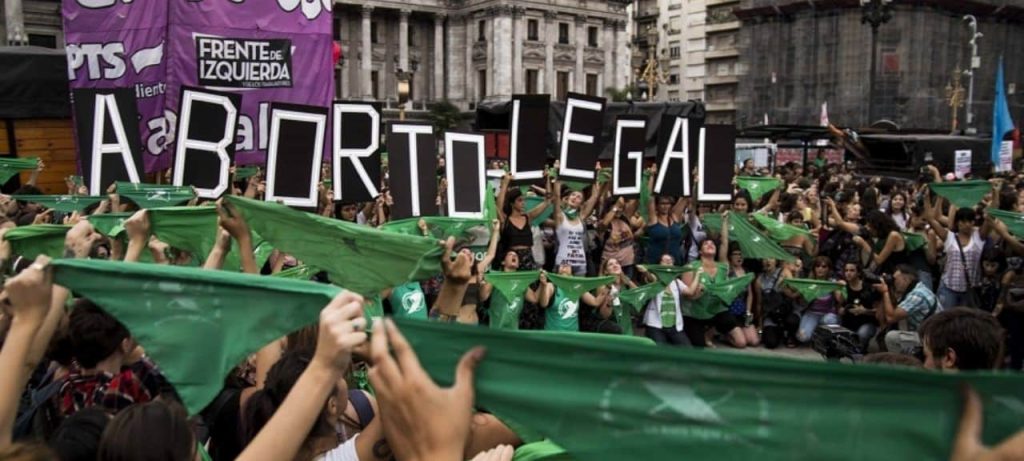Abortion rights are being turned back in the United States. What is to be done? NGOs call on people to donate money, while the Democratic Party says the only solution is to vote for them in November. In other parts of the Americas, abortion rights have been expanded. In the last year, Argentina, Mexico, and Chile all saw abortion bans lifted. These laws were not gifts from center-left governments. Legalization was won by militant movements on the streets — sometimes going back decades. The international socialist feminist organization Pan y Rosas (Bread and Roses) played a leading role in all these movements. Left Voice spoke to leaders of Pan y Rosas from three countries.

Argentina
Andrea D’Atri is the founder of the socialist feminist organization Pan y Rosas (Bread and Roses) in Argentina, and also an editor of La Izquierda Diario. Her book Bread and Roses: Gender and Class under Capitalism has been translated into half a dozen languages. An English edition was published by Pluto Press in 2019.
How was the right to abortion won in Argentina?
A law was passed on the night of December 30, 2021. If it had not been for the persistent struggles and mobilizations of the women’s movement, that bill would have remained in a desk drawer somewhere in parliament.
The fight to legalize abortion in Argentina goes back to the 1970s, before the military coup of 1976. When the military dictatorship fell, there was an enormous movement for human rights. So in the 1980s, abortion also began to be seen as a human right for women. Later, underground abortions were also understood to be a problem of public health. Legalizing abortion was not only about guaranteeing an individual right of pregnant people to decide, but also a right to not die of an unhygienic and unsafe abortion. That is why the women’s movement adopted the slogan “Sexual education in order to decide. Free contraceptives in order not to abort. Legal, safe, and free abortion in order not to die.”
Almost 20 years later, after many experiences of feminist struggles, the National Campaign for the Right to Abortion (CNDA), a coalition of more than 300 organizations, was founded in 2005. That year, the CNDA led mobilizations by thousands of people and presented a petition with 100,000 signatures to congress. These signatures were the result of an active movement that organized discussions and debates in schools and universities, as well as protests on busy street corners.
The CNDA presented a draft law for legalizing abortion in 2007. It had been written by the left-wing feminist lawyer Dora Coledesky, who passed away before our victory. This draft called for not only decriminalizing abortion but also making it legal in public hospitals, based solely on the request of a woman or pregnant person.
But this draft was never put up for debate during the center-left presidencies of Néstor and Cristina Kirchner. So the ban remained in place while the bill was introduced again and again. It was only the seventh time it was introduced, in 2018, that there was finally a debate in congress. At that time, Cristina Kirchner, then a senator, supported the bill — because she was in the opposition and she knew that the right-wing government of Mauricio Macri was going to prevent it from passing.
It was in 2018 that the “green wave” mobilized hundreds of thousands of people to surround the congress, and in many other cities in Argentina. Over months, protests were demanding that the law be put up for a vote. This was the culmination of countless protests. Year after year, people in Argentina had demonstrated for legal abortion on March 8 (Women’s Day) and September 28 (Day for the Decriminalization of Abortion in Latin America and the Caribbean). A high point had been in 2015, when a million people took to the streets across the country to protest against femicides, calling out “Ni una menos!” (Not one less).
In 2018 up to 300,000 people were at a vigil outside the congress during the long parliamentary sessions. The law was passed in the Chamber of Deputies, but it was rejected in the Senate. In the lower chamber, the Workers Left Front (FIT) had three deputies — we were the only parliamentary group to vote for the law unanimously. Pan y Rosas and the Party of Socialist Workers (PTS) were part of the huge green wave outside, while PTS members Nicolás del Caño and Nathalia González Seligra were members of parliament for the FIT and voted for the law.
What was the role of the center-left government of Alberto Fernández and Cristina Kirchner?
In 2019 the government of Alberto Fernández, with Cristina Kirchner as his vice president, promised that they would approve the law. They had to include this in their agenda because the movement on the streets had been so important, and many people placed hopes in this administration. The pandemic, however, demobilized the women’s movement. Fernández then ignored the draft bill which had been presented countless times by the CNDA, and instead introduced his own. His draft included restrictions that had been negotiated with reactionary sectors and the church, in exchange for the necessary votes. That’s how the law was finally passed. During the parliamentary debate, Nicolás del Caño of the PTS was the only deputy to denounce the restrictions introduced by the government, and he paid homage to Dora Coledesky and the women’s movement for making the law possible in the first place.
What role did Pan y Rosas play in the green wave?
Pan y Rosas is a socialist feminist organization launched by the Party of Socialist Workers (PTS), which had been part of the fight to legalize abortion since its founding. For years, the PTS was the only party that called for the legalization of abortion in its election campaigns. We always called for abortion to be free, safe, and available in public hospitals. We know that bans do not stop abortions — they only endanger the health and the lives of women and anyone who can get pregnant from the working class and the poor masses, who cannot afford to use clandestine medical clinics.
Our militancy in the workers’ movement, among precariously employed youth and students, in the poor neighborhoods, helped us combat prejudices and win over vast sectors to join the fight for abortion rights. Every time we led a struggle of the working class, we built up women’s commissions. Pan y Rosas mobilized more than 3,000 women from across the country to Argentina’s National Women’s Meeting. We were also on the streets confronting police repression.
In one of the most important food factories in Argentina, owned by a multinational corporation, we stopped production in protest when a supervisor harassed a woman worker. During the women’s strike, our comrades organized real work stoppages at other important factories to protest against femicides. We are on the front lines of struggles for democratic rights in this “democracy for the rich.” We fight for union rights for women workers, who make up the majority of the precariously employed and the poorest sector of the working class. But the horizon of our struggles is the radical transformation of this patriarchal, capitalist society, which is based on the exploitation of oppression of millions of human beings.

Mexico
Yara Villaseñor is a sociologist and an editor of La Izquierda Diario México. She is a leader of Pan y Rosas in Mexico.
Mexico was different: the right to abortion was not decided by Congress but rather decreed by the Supreme Court. What provoked this ruling?
The “progressive” government of Andrés Manuel López Obrador (AMLO) can rely on the massive discontent with the previous neoliberal governments for tepid political support. But it still has to respond to the aspirations of the mass movements — including the demands to end femicides and violence, and to win better living conditions. This is why the Supreme Court decided to decriminalize abortion — a demand that has been raised by tens of thousands of people in the streets in recent years. This was an attempt to pacify the women’s movement and reinforce confidence in the government and state institutions, which were being increasingly questioned.
What role did AMLO’s government play?
AMLO stayed on the sidelines. Although the governing party had a majority in both chambers of congress, deputies and senators, they refused to pass a bill decriminalizing abortion. It was only when the Supreme Court declared abortion bans unconstitutional at the state level that AMLO’s party began to move forward with initiatives to decriminalize abortion in the rest of the country. This is a conquest won by mobilizations under AMLO’s administration, but the government decided to not confront the church or the conservative Right, instead allowing a verdict by the Supreme Court to decriminalize abortion at a national level in September of last year. We also shouldn’t forget that AMLO has made many hostile statements about the women’s movement, claiming that it is controlled by the Right and solely aimed to destabilize his government. On the question of abortion, his position was to put this fundamental right to a referendum, which generated lots of discontent.
How did the women’s movement mobilize while the government dragged its feet?
The women’s movement here has developed in sync with the international feminist wave — Argentina and Chile have had a particular influence. A reformist consciousness dominates, with a lot of trust in certain institutions, owing to the influence of institutional feminism in this country. But there is impunity for 90 percent of femicides, anti-LGBTQ+ hate crimes, and forced disappearances of migrants. This violence has led people to question the government’s security strategy. This is why one of the government’s central policies has been to create new district attorneys for crimes against women. These punitive and carceral policies have generated sympathy among broad sectors who are seeking justice.
Many women workers are leading processes of organization and struggle against precarious working conditions and low salaries. They are organizing strikes and protests, but they are still not being recognized as political subjects with incredible social power, given their role in the economy. In fact, this is one our main struggles as Pan y Rosas: we believe that because the women’s movement is so massive, it can strengthen the ongoing struggles of workers; and we also seek to persuade the working class to take up feminist demands. We demand that the big unions place themselves at the service of the fight against femicides and violence, and for the right to abortion.
What does Pan y Rosas do more generally?
We aim to build up a wing in the women’s movement that is independent of the union bureaucracy, the government, and the conservative Right — one that sees the working class as an ally and that mobilizes for all of our demands. Pan y Rosas is one of the largest feminist organizations in Mexico. We can mobilize a thousand people at demonstrations. We organize in workplaces and schools with a socialist feminist perspective. Alongside other organizations, we run a national campaign for the right to abortion. We want to build a class-struggle wing of the women’s movement to fight on the streets against layoffs, social cuts, and precarious working conditions — and also for the right to legal, safe, and free abortion across the country.

Chile
Alejandra Decap studies linguistics at the University of Chile. She edits the section on Gender and Sexuality section of La Izquierda Diario Chile and is a leader of Pan y Rosas — Teresa Flores.
Chile recently experienced a rebellion. Starting in October 2019, millions of people took to the streets to protest the neoliberal regime. The country now has a new president, the former student leader Gabriel Boric, and is set to vote on a new constitution in September. How were abortion rights won in this process?
To start, we have to be very clear on this: the constituent process and Boric’s election served to empty the streets and divert the October Rebellion. Boric ran as a leftist, but he is governing in alliance with the Chilean capitalists and with U.S. imperialism. The draft constitution does recognize certain rights, but its purpose is to “modernize” the political regime and to restore governability, which was shaken by the rebellion. This new constitution would maintain fundamental pillars of the model of capitalist accumulation and the regime inherited from the dictatorship. It will not end the private pension schemes known as AFP, it would keep a presidential system and an oligarchic upper chamber, and it would continue to allow the plundering of natural resources, among other fundamental points.
So what is the status of abortion in Chile right now?
The old constitution, written under the dictatorship, had a ban on abortion. That has been dropped from the new constitution. But there are still no laws and no funding to provide for abortion access. So in Chile there is still no right to abortion — it is not legal, safe, or free. There is also no comprehensive sexual education. The new constitution would recognize the sexual and reproductive rights of all people; this is a product of years of struggle of the feminist movements for abortion rights. We from Pan y Rosas have no illusions about the new constitution. But as the plebiscite approaches, we call on people to confront the Right and the conservatives who are calling for a Reject vote — and also to confront the traditional parties of the Center Left who are looking for ways to further water down the constitutional text.
What role is Boric’s government playing regarding abortion rights?
Boric’s government talks a lot about feminism and women’s struggles, while their overall discourse has become much more moderate. Their program responds to sexist violence through punitive measures while placing rainbow flags on police cars. The government is using feminist language to give a left-wing look to its moderate policies. The coalition in power, Apruebo Dignidad (I Approve Dignity), which includes the Communist Party and the Frente Amplio (Broad Front), presented themselves as defenders of the constitutional process, but now they are becoming doubtful about the new constitution, because they are being pressured by the old center-left coalition that ran the country for 30 years and was questioned by the rebellion.
What kind of work does Pan y Rosas do in Chile?
We offer socialist feminist education in workplaces and universities. We organize women’s commissions in factories, hospitals, and schools. We have been part of workers’ strikes in hospitals and day care centers. We also ran socialist feminist candidates in national elections, as part of a revolutionary socialist front. We intervene in every progressive fight against oppression and exploitation, and we aim to build up a militant movement of women and LGBTQ+ people who struggle for revolution and socialism.
In Chile, Pan y Rosas is named after Teresa Flores. Who was that?
Teresa Flores was a union leader in Chile. She was a feminist and a communist militant — the only woman among the founders of the Socialist Workers Party (POS) in 1912, which later became the Communist Party. Together with her life partner, Luis Emilio Recabarren, she organized saltpeter workers and tried to give them political tools to fight capitalist exploitation. Flores was also an organizer of proletarian women and of housewives’ committees. She created spaces for working-class women to discuss and to educate themselves.
Do you have a message for people in the U.S. who are fighting to win back the right to abortion?
The only way to win all our rights is with organization and struggle on the streets. The main lesson we drew from the rebellion of 2019 in Chile is that we cannot place our trust in parties that, for the last 30 years, have dedicated themselves to running a regime that values profits more than our lives. We can only trust in our own force and mobilizations. That is what will permit us to win our demands. Under capitalism, no victory is permanent — that is why the struggle to liberate our bodies is directly linked to the struggle to end this system of misery and barbarism.
Interview: Nathaniel Flakin


